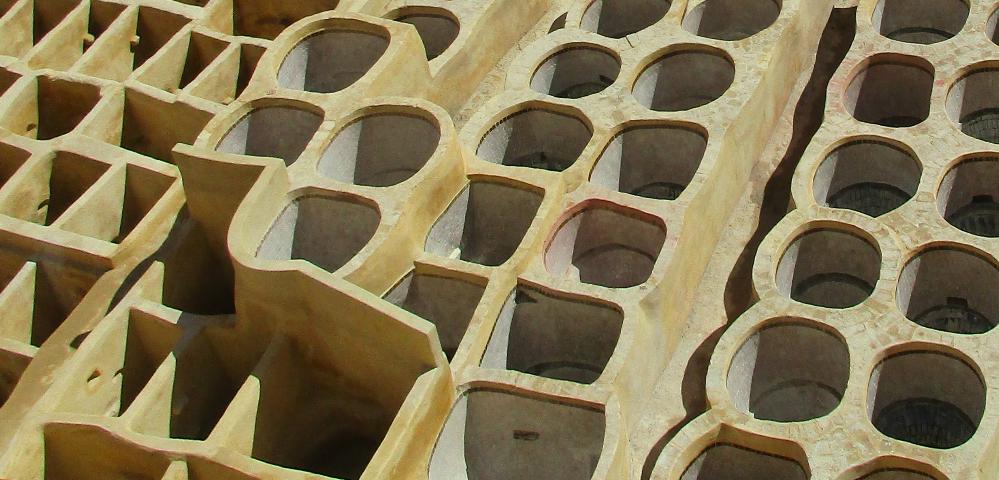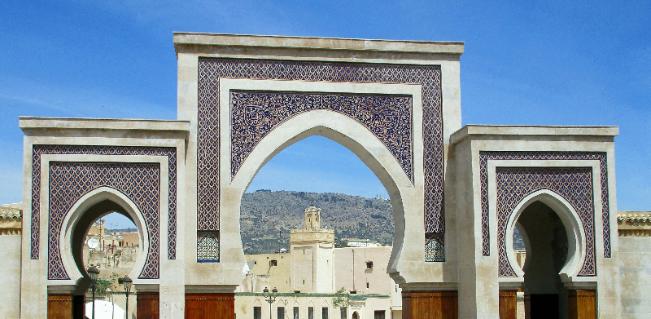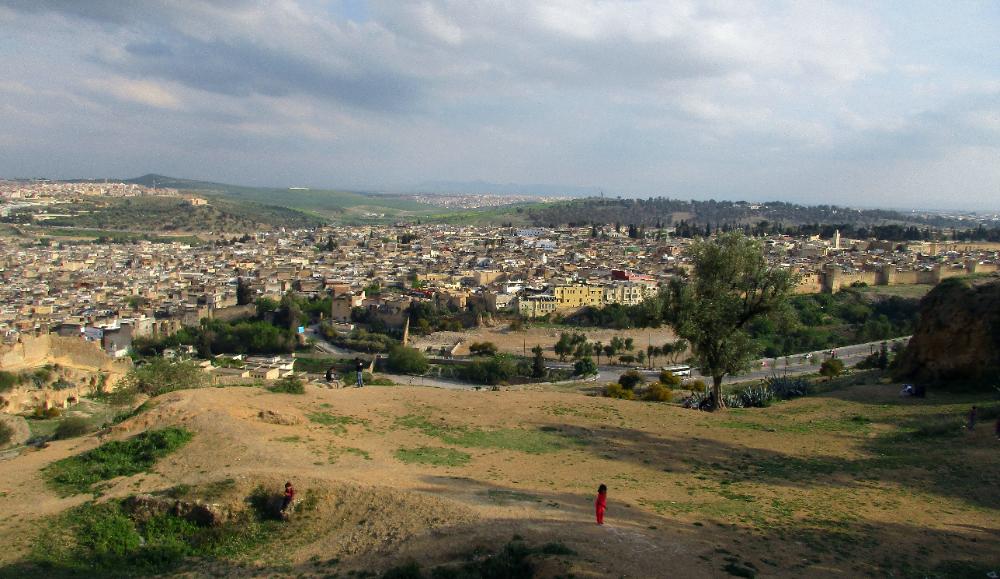
Where We Be




























| Fez, Morocco |
| Bab Boujloud |
Fez (or Fes) is considered the religious, cultural,
and handicrafts capital of Morocco. More than
most places on earth, this is a good place to
have a guide because the medina is so
confusing. There are said to be more than 9,400
streets and alleys winding through the medina,
some so narrow you can barely squeeze through
one at a time. Not to say you can't navigate the
maze on your own, but you'll see a lot more in a
day with a guide who knows his way around. Our
certified guide, recommended by our riad, ran
us $40 for a full-day tour of Fez al-Bali medina.
We'll talk about the sights we saw in a moment,
but first, a slice-of-life experience. As we were
making our way along a twisting alley, we heard
a squawking overhead and a chicken literally fell
from the sky, landing right in front of us. It began
running around the alley, quite distressed. A
minute later two boys came charging around the
corner looking for their chicken. Meanwhile, a
local man had shooed it into an open doorway
and closed the door, so the boys had to knock
repeatedly to get their chicken back. They finally
did, and the chicken squawked more than ever
as they carried it home. We'll never know if the
chicken was making a run for it or simply fell off
its rooftop coop by mistake, but quirky moments
like this are what make international travel fun.
and handicrafts capital of Morocco. More than
most places on earth, this is a good place to
have a guide because the medina is so
confusing. There are said to be more than 9,400
streets and alleys winding through the medina,
some so narrow you can barely squeeze through
one at a time. Not to say you can't navigate the
maze on your own, but you'll see a lot more in a
day with a guide who knows his way around. Our
certified guide, recommended by our riad, ran
us $40 for a full-day tour of Fez al-Bali medina.
We'll talk about the sights we saw in a moment,
but first, a slice-of-life experience. As we were
making our way along a twisting alley, we heard
a squawking overhead and a chicken literally fell
from the sky, landing right in front of us. It began
running around the alley, quite distressed. A
minute later two boys came charging around the
corner looking for their chicken. Meanwhile, a
local man had shooed it into an open doorway
and closed the door, so the boys had to knock
repeatedly to get their chicken back. They finally
did, and the chicken squawked more than ever
as they carried it home. We'll never know if the
chicken was making a run for it or simply fell off
its rooftop coop by mistake, but quirky moments
like this are what make international travel fun.
| We couldn't have been happier with our choice of lodging at Dar Hafsa. The riad is located deep within the medina, about a third of a mile from the Blue Gate. |
| And what a breakfast! |
| Sliced oranges with cinnamon are a common dessert in Morocco -- served here with strawberries and bananas |
| Moroccan hospitality is a real thing and not to be missed. Every evening the friendliest fellow in the world, Soufyane, would serve us mint tea as we enjoyed the rooftop views over Fez. |
| The owner, Abdul Kareem, will meet you at the Blue Gate and bring you here. There are just four rooms altogether, and ours only cost $47 with breakfast included. |
| Our favorite place for a simple meal was Kasbah Restaurant near Bab Boujloud. You can actually see the Blue Gate through the rooftop terrace screen, and in the other direction are gorgeous views at sunset of the mosque and university. |
| The views in the other direction are beautiful too. We didn't expect such lovely mountain vistas so close to the city. |
| Fez has a major claim to fame: it is home to the oldest university in the world, founded in 859 AD. Here's what Wikipedia has to say: "The University of Al Quaraouiyine...is the oldest existing, continually operating, and the first degree awarding educational institution in the world according to UNESCO and Guinness World Records." |
| This is the view of Bab Boujloud from the rooftop terrace of Kasbah Restaurant inside the medina |
| Our full-day guided tour started with a visit to Bab Boujloud, the Blue Gate, the most famous gate in Fez and possibly all of Morocco. Here we're outside the gate looking into the medina. |
| Al-Qarawiyyin University & Mosque |
| Bou Inania Medersa |
| Riad Ababou |
| Nejjarine Museum of Wood Arts |
| Moroccan Feast |
| Moroccan Handicrafts |
| Merenid Tombs |

| The 14th century tombs are in ruins, but you come here mostly for the views |
| Next day, our riad owner encouraged us to hike up to the Tombs of Merenid on our own. Great suggestion! |
| Fez is Morocco’s second largest city after Casablanca, with a population of 1.1 million (300,000 in the medina) |
| Fez reminded us of Jerusalem in that you could feel the sheer age of this ancient city, founded in 789 AD. Like Jerusalem, its streets slope downward as you go deeper into the oldest part of the medina and upward as you move towards its outer walls. |
| Next up was a leather tannery. Outside the shop we looked down on the recently restored vats used for coloring the leather. |
| We heard the King of Morocco was due for a visit to inaugurate the refurbished vats. They may never be this clean again! |
| At a rug making shop Robin got to try her hand at the loom |
| The rest of our tour day was a celebration of Moroccan handicrafts. Fez is the handicraft capital of Morocco and Nor said our tour wouldn’t be complete without a visit to certain kinds of shops. |
| Nor specifically recommended the pastilla, the national dish of Fez. It contains crisp layers of phyllo dough, savory meat slow-cooked in broth and spices, and a crunchy layer of toasted ground almonds, cinnamon, and sugar. |
| The restaurant setting was spectacular in its own right, and the entire amazing feast only ran us $24 US |
| Nor dropped us off at a terrific restaurant for lunch. This is just the appetizer -- eight "small plates" of Moroccan salads! |
| Next up: the Nejjarine Museum of Wood Arts. The building was once a fondouk -- a traveler’s lodge or caravansary. |
| The building is quite lovely with its three wooden tiers, and the rooms now display fine works of art in wood |
| We spent quite a bit of time exploring here. It's off the beaten path and something we never would have found without a guide. |
| Next we visited Riad Ababou, an old riad that has fallen into disrepair but still has a "decaying grandeur" |
| Al-Qarawiyyin Mosque isn't open to non-Muslims but you're allowed to peek in the front door. By tradition, other mosques of Fez only make the call to prayer after Al-Qarawiyyin. |
| We could tell Nor was proud of the fierce independence of Moroccans through time. They were the only North African country that wasn't colonized, although the French had a heavy influence here in a protectorate role. |
| With its carved cedar, fine stucco work, and geometric tile patterns, it’s definitely worth a visit |
| When we commented on certain similarities to the Alhambra in Spain, our guide grew enthusiastic, talking about Morocco and Spain and the endless back-and- forth of these two peoples, resulting in a distinctive Moorish architecture and culture |
| Nor told us how the Moors used colors in their geometric designs: yellow at the center for happiness, white for love (the connecting color), black for the unknown, blue for science / knowledge, and green for religion which bounds or contains all the rest |
| Our next stop was Bou Inania, the place we most wanted to see in Fez. It's the only in-use religious building non-Muslims may enter in Fez. |













| The university has distinctive green roofs when seen from above |
| The vats are still empty of dye but make for a highly interesting picture from above. This area of Fez is known as the Moulay Abdellah Quarter (Chouara). |

| Maybe the one chicken pushed the other chicken off the roof in a fit of chicken rage |








| Fez was the capital of Morocco until 1925 when the French moved it to Rabat |


| Food & Lodging |

| The medina of Fez is considered the world's largest contiguous completely car-free area. Many of its streets are too narrow to fit two people side by side, let alone a car! |



| The panorama of the city is spectacular from here |
| Besides breakfast, the owner and his daughter invited us to join them one evening for homemade chicken couscous -- incredibly generous of them |
